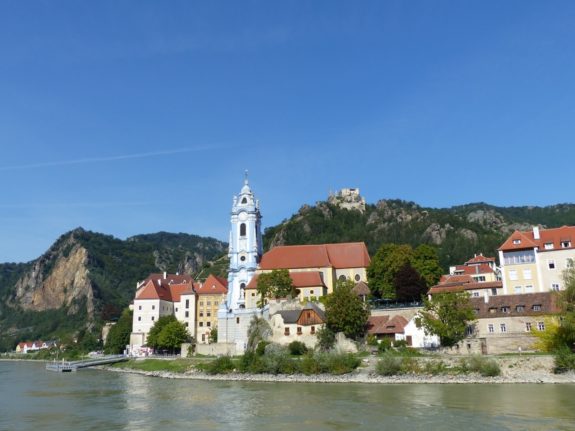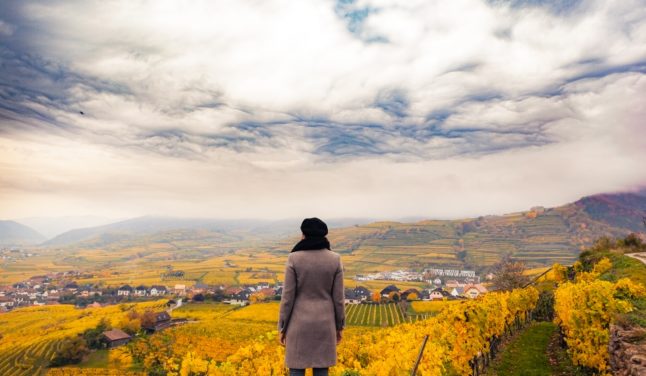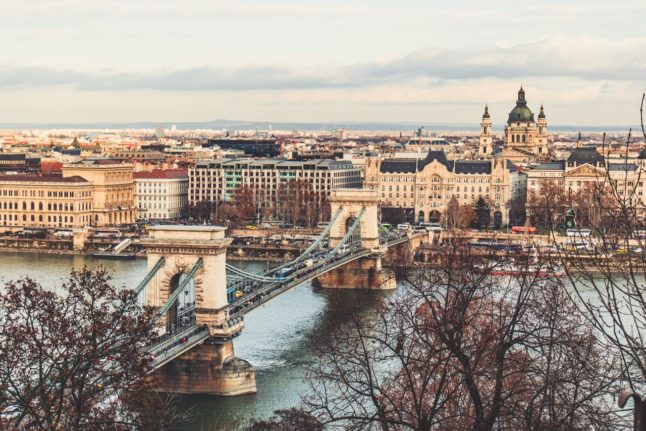Discover Austria: A guide through the Danube Valley

On its 2,900 km route from Germany’s Black Forest to the Black Sea, the Danube River flows through ten European countries, including Austria and its eastern neighbours, Slovakia and Hungary.
This stretch of river has been central to the region’s historical and cultural development for centuries and has seen a variety of picturesque towns and bustling metropolises emerge along its banks. Here is The Local’s guide to some of the best spots along the Danube Valley, following the river’s flow from west to east.
Wachau Valley: Melk, Dürnstein, Krems
In Austria, the Danube cuts through the northern part of the country and becomes particularly enticing just west of Vienna, in an area known as the Wachau Valley. Famous for its rolling hills and sweeping vineyards, the region has captured the hearts of artists, writers, and composers alike. The small town of Melk sits on the valley’s western edge and marks the entry point for our guide.
Melk’s main attraction is the stunning Melk Abbey, which stands on a hill overlooking the town and the river. It was rebuilt in the early 1700s after a fire burned down the original monastery, which was established in 1089.
READ ALSO: How the New Danube protects Vienna from catastrophic floods
The abbey church represents a breathtaking display of Baroque architecture, while the large marble hall and the elaborate library will also leave an impression. In addition, you can learn about the history of these buildings and the activities of the monks who still live at the abbey today by visiting the abbey museum.

Dürnstein, in Austria (Photo by Gabriele Strasky on Unsplash)
However, Melk Abbey is not the only famous abbey in the Wachau Valley. A little bit further east lies Dürnstein and its equally stunning baroque abbey, which can be identified by its iconic blue tower. The abbey recently opened an exhibition that allows tourists to visit previously inaccessible rooms, providing great insight into the building’s history.
Above the abbey stands the ruins of Dürnstein Castle, which was made famous by the legend of the English King, Richard the Lionheart. The hike to the castle is steep, but it will afford you great views across the valley, where you might even catch a glimpse of the final stop on the Wachau Valley tour: Krems.
READ ALSO: Discover Austria: Five beautiful hikes and destinations south of Vienna
Krems also has castles (Aggstein and Schönbühel) and an abbey (Gottweig) to its name, but the town’s art scene gives it a modern flair. The Kunsthalle Krems art gallery is in a former tobacco factory converted into an exhibition building in 1992 and displays modern and contemporary art. It is located along the city’s Kunstmeile (art mile), which also features a caricature museum and the Lower Austria State Gallery.

The Wachau Valley is beautiful in every season (Photo by Alex Gruber on Unsplash)
Finally, visiting Wachau Valley wouldn’t be complete without trying local wine. Luckily the Winzer Krems winery offers interactive tours through its vineyard and facilities.
Danube’s Big Three: Vienna, Bratislava, Budapest
As you continue following the Danube’s route east, you will arrive at some of its major cities. First up is Vienna, just a few hours from the Wachau Valley. The river is slightly away from the city centre and some of Vienna’s main tourist attractions. Still, the many biking and walking paths along its edges make it a popular destination regardless.
Just over the Austrian border lies the Slovakian capital of Bratislava. This compact city boasts a range of attractions, including an impressive old town, a unique Blue Church, and the towering Bratislava Castle, which provides a great look over the river.

READ ALSO: Discover Austria: 7 must-see destinations for a spring break
From Bratislava, the Danube snakes south into Hungary, where the capital city of Budapest also offers a world of delights. The Danube cuts through the city centre, dividing it into the Buda and Pest districts. The waterfront is home to the Buda Castle and Chain Bridge, among other landmark attractions.
With that, this guide through this fascinating portion of the Danube Valley comes to an end. As you can see, there is much to explore along the banks of Europe’s second-longest river. Enjoy!
Comments
See Also
This stretch of river has been central to the region’s historical and cultural development for centuries and has seen a variety of picturesque towns and bustling metropolises emerge along its banks. Here is The Local’s guide to some of the best spots along the Danube Valley, following the river’s flow from west to east.
Wachau Valley: Melk, Dürnstein, Krems
In Austria, the Danube cuts through the northern part of the country and becomes particularly enticing just west of Vienna, in an area known as the Wachau Valley. Famous for its rolling hills and sweeping vineyards, the region has captured the hearts of artists, writers, and composers alike. The small town of Melk sits on the valley’s western edge and marks the entry point for our guide.
Melk’s main attraction is the stunning Melk Abbey, which stands on a hill overlooking the town and the river. It was rebuilt in the early 1700s after a fire burned down the original monastery, which was established in 1089.
READ ALSO: How the New Danube protects Vienna from catastrophic floods
The abbey church represents a breathtaking display of Baroque architecture, while the large marble hall and the elaborate library will also leave an impression. In addition, you can learn about the history of these buildings and the activities of the monks who still live at the abbey today by visiting the abbey museum.

However, Melk Abbey is not the only famous abbey in the Wachau Valley. A little bit further east lies Dürnstein and its equally stunning baroque abbey, which can be identified by its iconic blue tower. The abbey recently opened an exhibition that allows tourists to visit previously inaccessible rooms, providing great insight into the building’s history.
Above the abbey stands the ruins of Dürnstein Castle, which was made famous by the legend of the English King, Richard the Lionheart. The hike to the castle is steep, but it will afford you great views across the valley, where you might even catch a glimpse of the final stop on the Wachau Valley tour: Krems.
READ ALSO: Discover Austria: Five beautiful hikes and destinations south of Vienna
Krems also has castles (Aggstein and Schönbühel) and an abbey (Gottweig) to its name, but the town’s art scene gives it a modern flair. The Kunsthalle Krems art gallery is in a former tobacco factory converted into an exhibition building in 1992 and displays modern and contemporary art. It is located along the city’s Kunstmeile (art mile), which also features a caricature museum and the Lower Austria State Gallery.

Finally, visiting Wachau Valley wouldn’t be complete without trying local wine. Luckily the Winzer Krems winery offers interactive tours through its vineyard and facilities.
Danube’s Big Three: Vienna, Bratislava, Budapest
As you continue following the Danube’s route east, you will arrive at some of its major cities. First up is Vienna, just a few hours from the Wachau Valley. The river is slightly away from the city centre and some of Vienna’s main tourist attractions. Still, the many biking and walking paths along its edges make it a popular destination regardless.
Just over the Austrian border lies the Slovakian capital of Bratislava. This compact city boasts a range of attractions, including an impressive old town, a unique Blue Church, and the towering Bratislava Castle, which provides a great look over the river.

READ ALSO: Discover Austria: 7 must-see destinations for a spring break
From Bratislava, the Danube snakes south into Hungary, where the capital city of Budapest also offers a world of delights. The Danube cuts through the city centre, dividing it into the Buda and Pest districts. The waterfront is home to the Buda Castle and Chain Bridge, among other landmark attractions.
With that, this guide through this fascinating portion of the Danube Valley comes to an end. As you can see, there is much to explore along the banks of Europe’s second-longest river. Enjoy!
Join the conversation in our comments section below. Share your own views and experience and if you have a question or suggestion for our journalists then email us at [email protected].
Please keep comments civil, constructive and on topic – and make sure to read our terms of use before getting involved.
Please log in here to leave a comment.